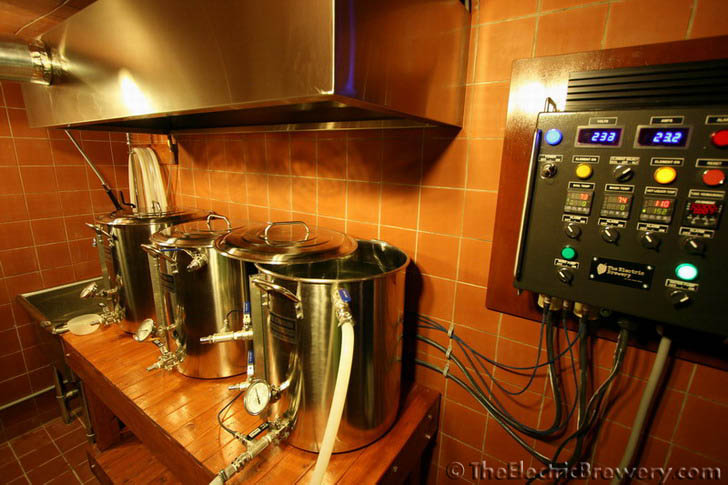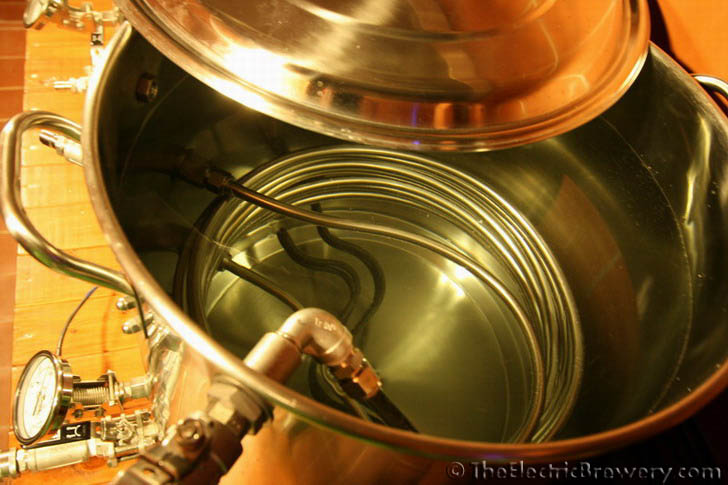Control the temp of the HLT water for the HERMS heat exchange. The further your temp probe gets from the heating medium, the larger your lag time and threat of temp overshoot.
If you think that temp overshoot is a myth, there are a few HBTers here that have built similar rigs and can testify to its reality.
NEVER control a HERMS or RIMS by measuring temp in the MLT. You need to have absolute control over the temp of the wort coming out of the heat exchanger.
The reason many people put the thermowell in the HLT water is that depending on your heat transfer to the coil, your HLT water could heat up to a temp that exceeds what you will desire. By the time your circulting wort reaches the wet point, the HLT is too hot and the subsequent wort throught the coil will overshoot.
YOU CAN USE A HERMS LIKE THIS FOR STEP MASHING!!!!
#1. Strike to rest at 122F, DO NOT RECIRCULATE
During this rest (15-20 min) you heat your HLT to 155F to obtain 152F in the MLT when you begin your recirc.
#2. After the 122F rest, begin the ricirc with your HLT set at 155F to obtain say a 152F rest in the MLT.
You will have no chance of overshoot, and you will be able to do step mashes easily. I speak from experience.
Yes, it would be nice to heat the HLT to 200F or so to get a quicker step up in temp, but you cannot do that in a HERMS or RIMS. You never want to heat your wort in excess of your target temp.
A PID will still overshoot if you put your temp probe in the wrong location. If you are measuring the mash temp at the MLT... and it is say 3F too cold... the PID will command heat in the HLT to raise the temp. The PID is NOT looking at the resultant HLT temp though, so when you DO reach your target MLT temp your HLT will be 170F, why... becuase your PID isnt looking at it, it has no idea what it just commanded in the HLT. Where your heating element resides, is where your tempo probe must reside, so that the PID can see what it is commanding and the actual result.
Total +1... I did many a step mash with my herms before I built my RiMS.... As long as you are reading the temp after the herms coil and before the mash, you should be fine.
Just to close the loop here what The Pol and Seabee John recommend is exactly what I've done, and it works perfectly. Read what they wrote above - Wise words from experience!
More and more RIMS just looks easier. Maybe a bit more expensive up front, but easier on brew day. Set temp, walk away. No math or anything... I'm simplifying some, but in HERMS you have to worry about 2 temps it seems, HLT and MLT. In RIMS, it's just one temp one heat source. Well, technically you are heating the HLT as well, but it's not part of the mash... For about $150, I can get a RIMS up. If you bought 3 boilermakers, you may or may not have the funds for that.
Not wanting to start the HERMS vs RIMS argument, just stating what I think will be best for me. YMMV.
Mine HERMS is set and walk away too. There's no temp difference between HLT and MLT. No offset.
To summarize my setup:
(From left to right: Brew Kettle, MLT, HLT)
The HLT with 50' HERMS coil, 5500W element, and water return at the top:
There is a 50 foot 1/2" stainless HERMS coil in the HLT along with a 5500W heating element controlled by a PID and temp sensor at the output (you can see the wire coming out of the 'T' junction at the bottom of the HLT). I recirc the HLT strike/sparge water full-tilt continuously with a pump.
I have nothing hooked up to the MLT in terms of temp control. I simply recirc the MLT wort through the HERMS coil in the HLT.
A temp probe located at the HERMS coil output on the HLT (see the second wire higher up on the "T" output) monitors the temp of temp of the returning mash fluid. It's not needed but it's nice to see and reminds me if I've forgotten to turn on the mash pump.

The mash probe temp always matches the HLT probe temp when the pumps are running as it should since it's right at the output of the coil.
In my setup I found the easiest thing to do is to simply fill the MLT with the right amount of strike water, fill the HLT, and then set the HLT to the mash temp (let's say 152F). Turn on the pumps and let everything heat up and equalize. After ~30 mins or so both vessels are at 152F. I then turn off the mash pump and dough in. The mash temp drops due to the room temp grain of course. Once doughed in I turn the mash pump back on and after a few minutes my the grain bed is back up to 152F everywhere (I used a known accurate meat probe the first time through to measure the temp in various spots in the grain bed and they were all exactly at 152F after ~20 minutes - I just need to make sure to recirc the mash fast enough to avoid stratification).
This seems to work great for me and results is zero guesswork or having to know the offsets between tanks. I don't need to worry about offsets at all. I just dial in the mash strike temp on the HLT PID, let the water in both vessels heat up to strik temp, dough in, then set the timer to 60-90 minute mash time (plus an extra 15-20 for the mash to ramp back up to strike temp) and walk away. The alarm/timer on my control panel lets me set a reminder when the next action is needed (mashout). At mashout I simply crank the HLT temp up to 170F and 15-20 minutes later the entire grain bed's at 170F ready for sparging. Simple!
Kal




